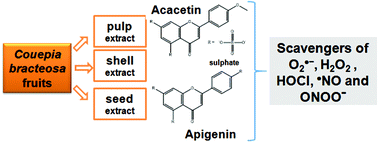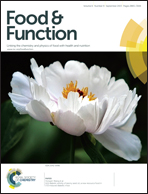The seed of the Amazonian fruit Couepia bracteosa exhibits higher scavenging capacity against ROS and RNS than its shell and pulp extracts
Abstract
Among the large number of scientifically unstudied fruits from the Amazonia biome, Couepia bracteosa acts as an interesting source of bioactive compounds, such as phenolic compounds and carotenoids, which may be used for protecting human health against oxidative damage. For the first time, the phenolic compounds and carotenoids in extracts obtained from the pulp, shell and seeds of C. bracteosa fruits are reported, as well as their in vitro scavenging capacities against some reactive oxygen species (ROS) and reactive nitrogen species (RNS). The shell extract presented the highest phenolic compound and carotenoid contents (5540 and 328 μg per g extract, dry basis, respectively), followed by the pulp and seed extracts. The major phenolic compound was acacetin sulphate (one methoxy and two OH groups) (62%) in the shells; however, only seeds presented apigenin sulphate (three OH groups), in which it was the major compound (44%). The high content of apigenin sulphate may explain why the seed extract had the highest scavenging efficiency against all tested ROS/RNS among the studied extracts. Regarding carotenoids, all-trans-neochrome (17%) and all-trans-β-carotene (16%) were the major carotenoids in the pulp extracts, while all-trans-lutein (44%) was the most prevalent in the shell extracts and all-trans-α-carotene (32%) and all-trans-β-carotene (29%) were the major ones in the seed extracts.



 Please wait while we load your content...
Please wait while we load your content...